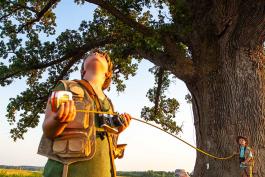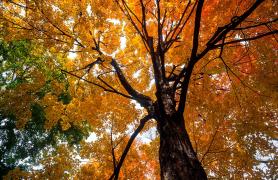
Finding big trees takes savvy, skills, and a little help from a friend.
Some big trees are easy to spot. Missouri’s champion bur oak near McBaine stands like a giant in a bottomland crop field. This old fighter is 74 feet tall, 295 inches around, and its outermost branches reach 129 feet across. It’s big!
Other champs are barely noticeable. Missouri’s champion farkleberry (yep, farkleberry, aka winter huckleberry) is only 14 feet tall and 12 inches around. That’s because it’s naturally a small, shrubby tree. But every champion eventually falls — or someone (like you) finds an even bigger tree that takes its prize.
Get to Know Missouri’s Trees
Before you head outside, take a little time to learn about Missouri’s trees. To be a champion, a tree must be native to Missouri. You can find all 137 kinds that are qualified to be champions at mdc.mo.gov/champion-trees.
Look Near and Far
Trees grow big when they have few competitors. That’s why almost half of Missouri’s champions are found in farms, city parks, campuses, and cemeteries. In these places, trees can branch out and soak up the sun and rain. Missouri champions also tend to be found in conservation areas, state parks, and national forest lands. These places are carefully managed, but natural forces like storms can clear away weaker trees, leaving the strong to get even stronger (and bigger!).
Champions by the Numbers
The most points:
With a total of 456 points, a bald cypress on private land in New Madrid County is Missouri’s biggest champion tree (and it has the biggest trunk).
2nd biggest trunk:
A water tupelo at Allred Lake Natural Area in Butler County is 322 inches around.
The tallest:
A scarlet oak at Lake Wappapello in Wayne County is 150 feet tall.
The widest crown:
A cherrybark oak in Scott City Park in Scott County has a crown spread of 138 feet.
Tree ID Tips
Every tree has a few features that will help you learn to spot it. Pay attention to leaves, nuts, fruit, and bark.
It also helps to carry a good tree field guide. Pack along the tree mini guide on Page 10, or get a copy of Trees of Missouri Field Guide.
How to Measure a Giant
Even before you start hunting big trees, it’s fun to practice measuring trees in your yard, farm, or neighborhood park.
Here’s What You Need
- A friend to help you
- 30 feet of rope or cord
- A clothespin
- Really long tape measure
- 4 tent stakes and 1 hammer (for your friend)
- Your thumb
Here’s What You Do
Champion trees are judged by their height, trunk circumference (length around) at 4.5 feet above ground, and crown spread (average width from dripline to dripline).
Height
If you know your friend’s height (let’s say it’s 5 feet), have them stand right next to the tree. Raise your arm straight out and put your thumb up. Walk forward or backward until your thumb is the same size as your friend. Eyeball that spot, and then raise your hand up one thumb-length. Do this until you reach the top of the tree. Multiply the number of times you raised your thumb by your friend’s height. If it was 10 times, your tree is 50 feet tall.
Circumference
Have your friend hold the end of the tape measure on the ground at the base of the tree. Pull the measure up along the trunk until you see the mark at 4 feet 6 inches. At this height, wrap rope or cord around the tree’s trunk.
When you get all the way around, clip a clothespin at the spot where the free end of the cord meets the place where you started. Stretch the cord out straight and measure from the end of the cord to the clothespin. This is the tree’s circumference.
Crown spread
Starting at the trunk, walk to the farthest edge of your tree’s dripline. This is where the outermost branches would shed rainwater onto the ground. Hammer a stake in the ground or place a rock at that point. Go to the opposite side of the trunk and do this again.
Do the same thing for the shortest line passing through the middle of the crown. Measure both distances with your tape measure.
Add the two distances together and divide by 2. This is the crown’s average spread.
Example: widest distance of 36 feet + shortest distance of 28 feet = 64. Divided by 2 = 32 feet
Add up Your Score
Here’s the formula the Missouri Department of Conservation uses to figure out a point value for big trees:
Height (in feet) + Circumference (in inches) + 1/4 of the average crown spread (in feet) = Tree Score
Your tree’s score might look something like this:
15 (feet) + 28 (inches) + 8 (1/4 of the average crown spread [32 feet ÷ 4 = 8]) = 51
Send in Your Contender
If you think your tree could beat the current Missouri champion, take a pic, and send it to the Missouri Department of Conservation’s Champion Tree Program. Before you do, be sure to visit mdc.mo.gov/champion-trees to check the current list of champion trees and download the nomination form.
Plant a Future Champion
Every year, the George O. White State Forest Nursery grows millions of tree seedlings for conservation projects and wildlife habitat. They’re inexpensive and easy to order. The seedling you plant could become a future champion. Order at mdc.mo.gov/seedlings.
Have you got what it takes to bag big trees?










Also In This Issue

Attention, tree huggers! Leaf it to this field guide to help you get acquainted with your barky buddies.
And More...
This Issue's Staff
Les Fortenberry
Alexis (AJ) Joyce
Angie Daly Morfeld
Noppadol Paothong
Marci Porter
Laura Scheuler
Matt Seek
David Stonner
Stephanie Thurber
Cliff White






















